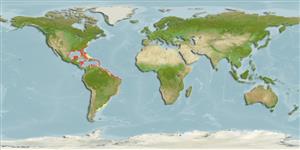>
Eupercaria/misc (Various families in series Eupercaria) >
Sparidae (Porgies)
Etymology: Archosargus: Greek, archo = anus + Latin , sargus = sea bream (Ref. 45335).
More on author: Linnaeus.
Environment: milieu / climate zone / profondeur / distribution range
Écologie
marin; saumâtre récifal; profondeur 1 - 40 m (Ref. 115835). Subtropical; 22°C - 30°C; 41°N - 58°S, 98°W - 34°W
Western Atlantic: New Jersey, USA and northeastern Gulf of Mexico to Argentina (Ref. 4517). Absent from the Bahamas (Ref. 26938).
Length at first maturity / Taille / Poids / Âge
Maturité: Lm 8.0 range ? - ? cm
Max length : 33.0 cm TL mâle / non sexé; (Ref. 7251); common length : 20.0 cm TL mâle / non sexé; (Ref. 9626); poids max. publié: 550.00 g (Ref. 9626); âge max. reporté: 2.00 années (Ref. 3422)
Épines dorsales (Total) : 13; Rayons mous dorsaux (Total) : 10 - 11; Épines anales: 3; Rayons mous anaux: 10 - 11. Large intestine makes up 90% of digestive tract and is twice the standard length, on the average; the stomach with 7 digestive caeca attached near the pyloric region. Pelvic fin coloration totally or partially dark in males; orange colored in females. Large dark spot (about same size as eye) below lateral line just behind gill opening (Ref. 26938).
Body shape (shape guide): short and / or deep.
Commonly found over mud bottoms in mangrove sloughs and on vegetated sand bottoms, sometimes in brackish water and occasionally also in coral reef areas near mangroves. Feeds on benthic invertebrates (small bivalves, crustaceans), as well as on plant material.
Robins, C.R. and G.C. Ray, 1986. A field guide to Atlantic coast fishes of North America. Houghton Mifflin Company, Boston, U.S.A. 354 p. (Ref. 7251)
Statut dans la liste rouge de l'IUCN (Ref. 130435: Version 2025-1)
Menace pour l'homme
Harmless
Utilisations par l'homme
Pêcheries: commercial
Outils
Articles particuliers
Télécharger en XML
Sources Internet
Estimates based on models
Preferred temperature (Réf.
123201): 22.8 - 28, mean 25.8 °C (based on 456 cells).
Phylogenetic diversity index (Réf.
82804): PD
50 = 0.6250 [Uniqueness, from 0.5 = low to 2.0 = high].
Bayesian length-weight: a=0.02042 (0.01732 - 0.02406), b=2.98 (2.93 - 3.03), in cm total length, based on LWR estimates for this species (Ref.
93245).
Niveau trophique (Réf.
69278): 2.9 ±0.1 se; based on diet studies.
Résilience (Réf.
120179): Haut, temps minimum de doublement de population inférieur à 15 mois (K=1.27; tm=0.4; tmax=2).
Fishing Vulnerability (Ref.
59153): Low vulnerability (23 of 100).
🛈
Climate Vulnerability (Ref.
125649): Moderate vulnerability (42 of 100).
🛈
Nutrients (Ref.
124155): Calcium = 67.7 [24.2, 130.8] mg/100g; Iron = 1.06 [0.47, 2.36] mg/100g; Protein = 20.3 [18.8, 21.8] %; Omega3 = 0.187 [0.084, 0.425] g/100g; Selenium = 24.2 [8.6, 62.8] μg/100g; VitaminA = 9.19 [1.53, 59.55] μg/100g; Zinc = 1.08 [0.60, 1.89] mg/100g (wet weight);
